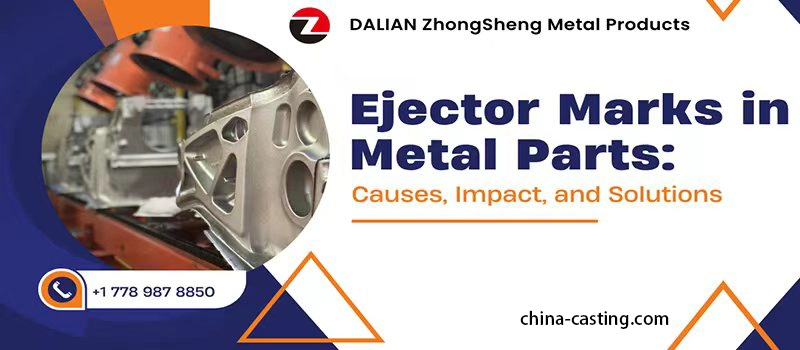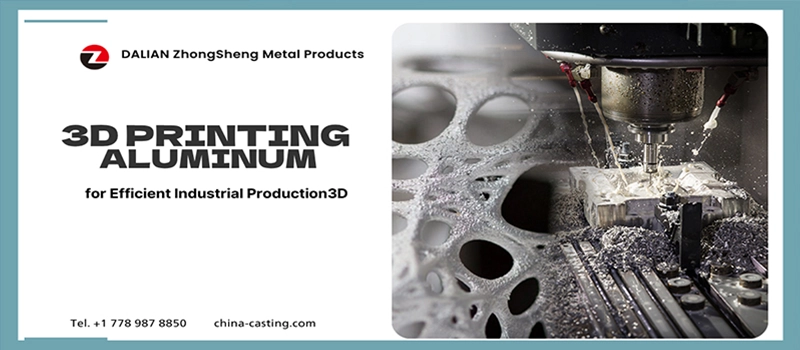In today’s manufacturing landscape, dimensional inaccuracy, surface defects, and delivery delays often stem from outdated machining processes or inconsistent supplier performance. These issues are especially critical when dealing with tight tolerances, complex geometries, or high-volume orders.
CNC milling provides a precise, repeatable, and programmable solution. By leveraging computer numerical control, manufacturers can convert digital designs into high-accuracy components with consistent quality, reduced lead time, and optimal material utilization.
✅ What Is CNC Milling?
CNC milling is a computer-controlled machining process that removes material from a solid workpiece using rotary cutters. The term “CNC” stands for Computer Numerical Control, which refers to the digital automation of machine movement based on G-code instructions derived from a CAD model.
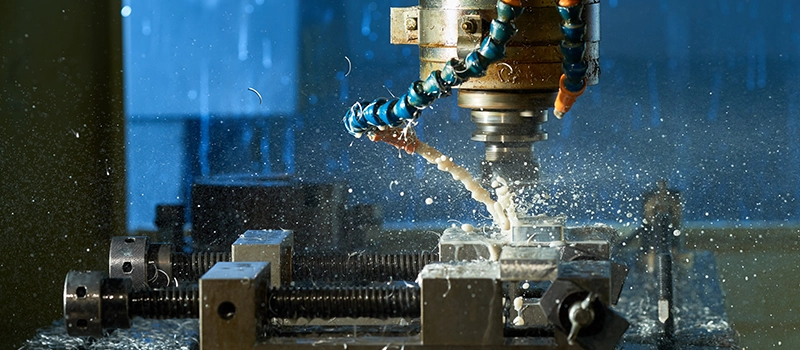
In contrast to manual milling, CNC systems automate all motion along the X, Y, and Z axes, with some machines adding rotational axes (A, B, or C) for more complex geometries. The result is high-precision, repeatable manufacturing of components with tight tolerances—often down to ±0.005 mm.
CNC milling machines support various operations, including facing, pocketing, slotting, contouring, and drilling, making them suitable for single-piece prototypes or large-scale production. Machines are available in several configurations, including:
- 3-axis vertical milling machines – standard for general-purpose work
- 4-axis and 5-axis machines – for multi-surface or high-complexity parts
- Benchtop and desktop CNC mills – used for light-duty applications and prototyping
- Horizontal milling machines – better suited for heavy chip loads and deeper cuts
These machines are capable of processing a wide range of materials, from aluminum and stainless steel to titanium, plastics, and composites, depending on machine rigidity and tooling.
In industrial environments, CNC milling is a core process for sectors like aerospace, automotive, energy, agriculture, and medical, offering unmatched control over part geometry, production speed, and consistency.
✅ How CNC Milling Machines Work
CNC milling machines operate through the precise coordination of computer-controlled systems that guide mechanical components—primarily the spindle, tool changers, and linear motion axes. These machines transform digital instructions from a CAD (Computer-Aided Design) file into mechanical actions using a CAM (Computer-Aided Manufacturing) program that generates G-code. This code instructs the machine on where to move, how fast, and what depth or angle to cut.
🔧 Workflow: From CAD to Finished Part
- CAD Model Creation:
Engineers design the part using 3D modeling software like SolidWorks, AutoCAD, or Fusion 360. This model defines all critical dimensions, hole placements, contours, and tolerances. - CAM Programming & Tool Path Generation:
The CAD file is imported into CAM software, where machinists assign cutting tools, set feed rates, and determine the tool paths. The result is G-code—numerical instructions for the CNC controller. - Setup and Workholding:
The operator secures the raw material (metal or plastic block) onto the machine bed or a vice. Proper fixturing is essential to maintain part stability and dimensional accuracy. - Zeroing and Calibration:
The machine is calibrated—setting the X, Y, and Z origins (known as “work zero”). Tool lengths and offsets are measured and loaded into the machine’s controller. - Automated Milling:
The machine executes the programmed instructions, controlling the spindle speed (RPM), tool position, feed rate, and coolant delivery. Material is removed layer by layer using operations like facing, pocketing, contouring, and drilling. - Tool Changes (if multi-op):
For complex parts, automatic tool changers (ATC) switch between end mills, drills, or ball nose tools as needed—ensuring efficiency without manual intervention. - Quality Control & Deburring:
Once milled, the part is inspected against dimensional tolerances using CMM (Coordinate Measuring Machine), calipers, or micrometers. If required, manual deburring and finishing are performed.
⚙️ Key Components of a CNC Milling Machine
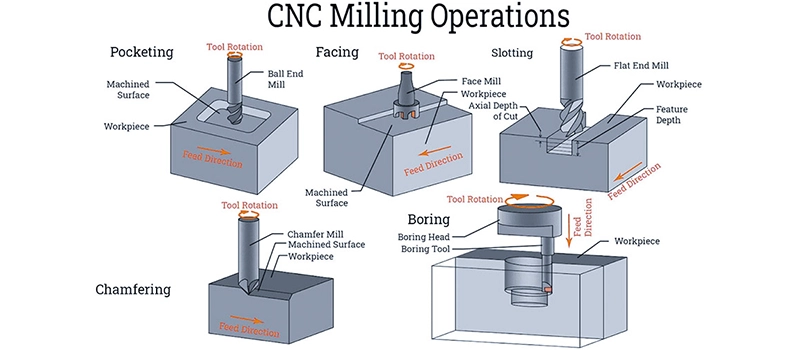
- Spindle:
The rotating shaft that holds the cutting tool. Speed-controlled by the CNC system (e.g., 3,000 to 30,000 RPM), depending on material. - Worktable / Bed:
The surface on which the raw material is fixed. Often moves in X and Y directions, while the spindle moves along the Z-axis. - Ball Screws & Linear Guides:
Responsible for smooth, backlash-free movement of machine components with high precision and repeatability. - Controller (CNC Computer Unit):
The brain of the system that interprets G-code and converts it into precise electric signals for motors and servos. - Automatic Tool Changer (ATC):
Found in higher-end or industrial machines; allows seamless multi-tool operations within a single cycle. - Coolant System:
Delivers coolant directly to the cutting zone to manage temperature, flush chips, and extend tool life.
🛠️ Machine Movements & Axes
- 3-Axis Milling:
Moves along X (left/right), Y (forward/back), and Z (up/down). Common for simpler parts. - 4-Axis Milling:
Adds A-axis (rotational movement around X). Useful for cylindrical features or side milling. - 5-Axis Milling:
Adds both A and B (or C) rotational axes. Allows the spindle and table to tilt, enabling complex, multi-face machining without repositioning.
This movement capability is what makes 5-axis CNC milling machines essential in aerospace and medical industries, where one-piece, complex geometry is standard.
✅ Types of CNC Milling Machines
CNC milling machines are categorized based on their axis configuration, machine orientation, and size. The right machine type depends on the part geometry, production volume, and material requirements.
🔁 Axis Configuration
- 3-Axis Machines
Move along X, Y, and Z axes. Ideal for basic geometries and flat surface machining. Common in general-purpose fabrication. - 4-Axis Machines
Add A-axis (rotational) movement around the X-axis. Enable side features and cylindrical part machining without manual repositioning. - 5-Axis Machines
Provide simultaneous movement along three linear and two rotational axes. Essential for multi-face, complex components in aerospace, medical, and mold manufacturing.
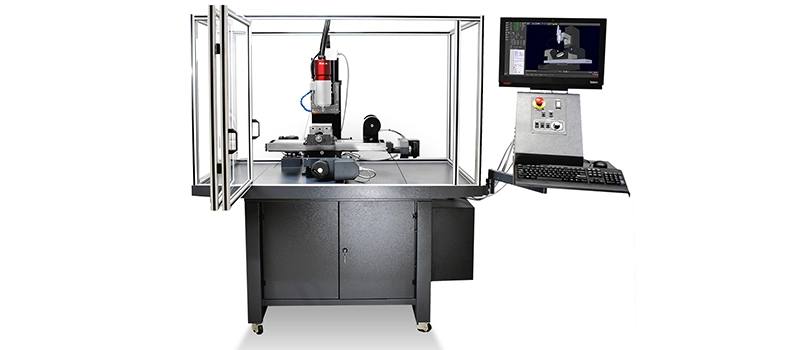
🏗️ Machine Orientation
- Vertical Milling Machines (VMCs)
Spindle is vertically aligned. Widely used due to compact footprint and easy setup. Suitable for 2D contouring and face milling. - Horizontal Milling Machines (HMCs)
Spindle is horizontally aligned. Better for large-volume production, deep cutting, and efficient chip removal.
🧰 Form Factor: Benchtop & Desktop Machines
- Benchtop CNC Mills
Compact but rigid. Used for small-part production, tool making, and low-volume machining. - Desktop CNC Milling Machines
Lightweight and space-saving. Best suited for prototyping, hobby machining, and soft materials like plastics or aluminum.
Each machine type offers trade-offs in cost, complexity, footprint, and machining capability. Understanding these differences ensures optimal equipment selection for your specific application.
✅Materials Used in CNC Milling
The effectiveness of CNC milling lies not only in its precision and automation but also in its compatibility with a wide range of engineering materials. These materials are selected based on mechanical performance, machinability, and application requirements.
🔩 Metals
Aluminum
The most commonly milled metal due to its excellent machinability, strength-to-weight ratio, and corrosion resistance. Suitable for aerospace components, automotive housings, and consumer electronics frames.
Steel (Mild, Carbon, Stainless)
Steel variants offer higher strength and wear resistance but require slower cutting speeds and tougher tooling. Used in structural parts, gearboxes, and heavy equipment.
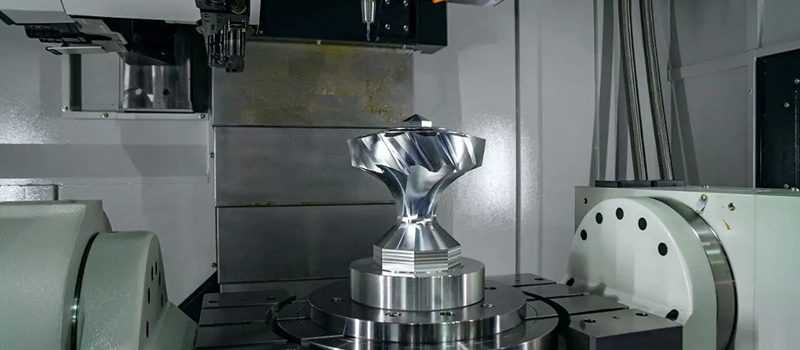
Brass and Copper
Chosen for their electrical conductivity and tight tolerancing capability. Often used in electrical connectors, valves, and heat sinks.
Titanium
High strength-to-weight ratio and excellent biocompatibility make it ideal for medical implants and aerospace applications, though it demands robust machine rigidity and optimized cutting parameters.
🔧 Plastics
CNC milling is also widely used for engineering plastics like:
- ABS – Prototyping and low-strength applications
- Nylon – Gears, insulators, wear components
- PEEK – High-performance applications in aerospace and medical industries
🌲 Other Materials
- Wood: Light-duty desktop CNC mills are used in prototyping and woodworking
- Composites: Specialized tools and low feed rates are required, especially for carbon fiber
Material choice is critical—it impacts tool selection, cutting strategy, spindle speed, and cooling requirements. In precision manufacturing, understanding these material behaviors ensures better surface finish, reduced tool wear, and consistent dimensional tolerances.
✅Applications of CNC Milling Across Industries
CNC milling plays a foundational role in precision component production across high-demand sectors. Its ability to deliver tight tolerances, repeatability, and complex geometries makes it essential in both prototyping and mass production environments.
🚗 Automotive
CNC milling is used to machine engine blocks, gearbox housings, suspension components, and aluminum transmission parts. 3-axis and 5-axis milling are deployed for structural parts, bracketry, and custom performance components.
- Key Requirements: Dimensional consistency, batch repeatability, material strength
- Materials: Aluminum, cast iron, steel alloys
✈️ Aerospace
Due to strict tolerance and surface finish requirements, 5-axis CNC milling is standard for aerospace parts like turbine blades, structural frames, seat components, and titanium brackets.
- Key Requirements: Lightweighting, surface integrity, zero-defect production
- Materials: Titanium, aluminum, Inconel, PEEK composites
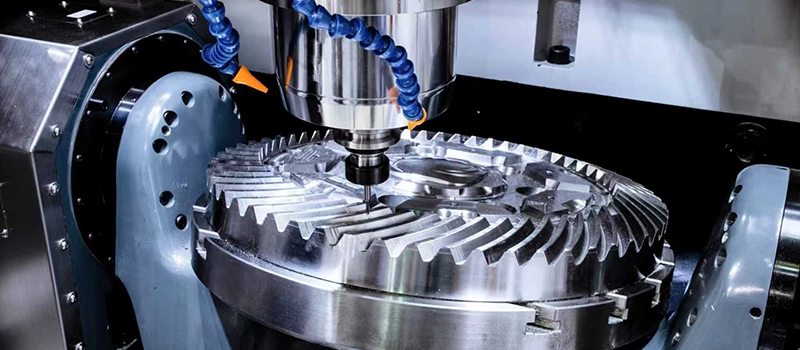
🏥 Medical & Dental
CNC milling is used for surgical tools, orthopedic implants, and dental prosthetics. Precision machining ensures compatibility with human anatomy and regulatory compliance (ISO, FDA).
- Key Requirements: Biocompatibility, micromachining, traceability
- Materials: Titanium, stainless steel, PEEK, medical-grade plastics
🛢️ Energy and Petrochemical
Valve bodies, sealing components, pump housings, and heat exchanger parts are commonly milled for oil, gas, and renewable energy systems.
- Key Requirements: Corrosion resistance, pressure endurance
- Materials: Stainless steel, duplex steel, aluminum-bronze
🚜 Agriculture & Construction
CNC mills produce high-durability parts such as couplings, linkage arms, brackets, and housings for heavy-duty equipment. Tolerances and cycle life matter due to harsh working environments.
- Key Requirements: Mechanical durability, weldability, field serviceability
- Materials: Structural steels, manganese alloys, carbon steel
In all these industries, CNC milling’s ability to handle complex geometries, precision fits, and rapid changeovers gives manufacturers the flexibility to respond to both high-volume orders and small-batch custom parts — without sacrificing quality or lead time.
✅CNC Milling in Real Life: A Case You See Every Day
CNC milling is not limited to industrial or aerospace applications—it plays a direct role in manufacturing products we interact with every day. One of the most visible and technically demanding examples is the aluminum unibody housing of smartphones and laptops.
Need Help? We’re Here for You!
📱 Case Study: Smartphone Aluminum Frame
The sleek, precise, and uniform body of a modern smartphone is typically machined from a solid billet of 6xxx or 7xxx series aluminum. The manufacturing process begins with a raw rectangular block, which is then CNC milled using a 5-axis vertical machining center.
Key operations include:
- Rough pocketing: to remove bulk material from internal cavities
- Perimeter profiling: to achieve tight external dimensions
- Drilling and tapping: for button holes, camera mounts, and connectors
- Chamfering and deburring: for edge refinement and user comfort
- Surface finishing: followed by anodizing or bead blasting for aesthetic quality
💻 Laptop Housings and Heat-Sinks
Similarly, milled aluminum laptop housings offer strength, thermal performance, and tight integration of components. The machining process allows for:
- Complex internal pockets for component placement
- Precision cutouts for ports and fasteners
- Surface flatness required for screen and keyboard alignment
- High-quality finishes needed for consumer-facing parts
The use of 5-axis CNC mills enables consistent wall thickness, part symmetry, and critical alignment features to be machined in a single fixture—minimizing error accumulation.
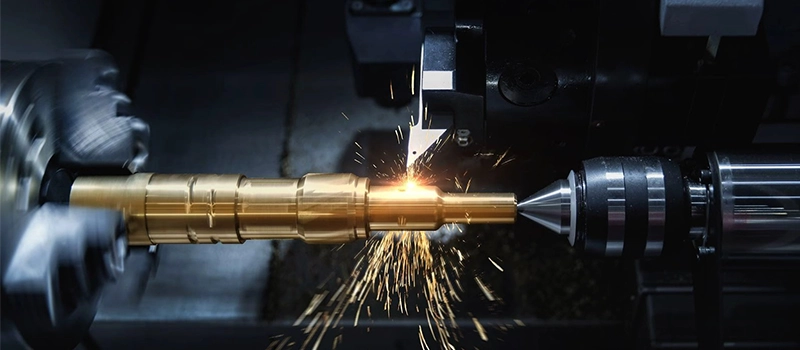
🚗 Automotive Interiors and Trim Components
In high-end automotive applications, decorative aluminum trim and control panels are CNC milled for aesthetic and ergonomic precision. These parts may include tactile grooves, relief patterns, or logo engraving—all achievable through CNC programming.
These examples demonstrate that CNC milling is not just a tool for factories—it shapes the form, fit, and function of devices we use every day. When you hold a smartphone or open a laptop, you’re interacting with a surface that was likely machined with micron-level accuracy using a multi-axis CNC mill.
✅ Conclusion
CNC milling is a foundational technology in modern manufacturing—delivering unmatched precision, repeatability, and flexibility across industries. Whether for aerospace brackets, medical implants, or consumer electronics housings, CNC milling bridges the gap between digital design and physical reality with micron-level control.
As part geometries become more complex and tolerances more demanding, CNC milling remains essential to maintaining quality, reducing waste, and accelerating time to market.


